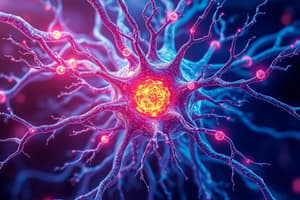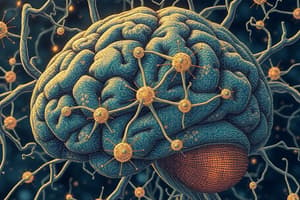Podcast
Questions and Answers
What role does GTP play in the function of G protein-coupled receptors (GPCRs)?
What role does GTP play in the function of G protein-coupled receptors (GPCRs)?
- It catalyzes the phosphorylation reaction.
- It binds and releases energy for signaling. (correct)
- It serves as a structural component of the receptor.
- It directly activates the receptor.
What is a characteristic feature of receptor tyrosine kinases (RTKs)?
What is a characteristic feature of receptor tyrosine kinases (RTKs)?
- They only activate G proteins.
- They have enzymatic activity to transfer phosphate groups. (correct)
- They are found exclusively in the nucleus.
- They act as second messengers.
How does phosphorylation influence protein activity?
How does phosphorylation influence protein activity?
- It involves the removal of phosphate groups.
- It always activates proteins.
- It guarantees the synthesis of new proteins.
- It can either activate or deactivate proteins. (correct)
Where are intracellular receptor proteins typically located?
Where are intracellular receptor proteins typically located?
What is the purpose of a phosphorylation cascade?
What is the purpose of a phosphorylation cascade?
Which of the following is NOT considered a second messenger?
Which of the following is NOT considered a second messenger?
What is a common outcome of cell signaling pathways?
What is a common outcome of cell signaling pathways?
How do small molecules and ions function in cell signaling?
How do small molecules and ions function in cell signaling?
What phenomenon allows bacterial cells to monitor local density through signaling molecules?
What phenomenon allows bacterial cells to monitor local density through signaling molecules?
What type of signaling occurs when signaling molecules secrete by a cell travel short distances?
What type of signaling occurs when signaling molecules secrete by a cell travel short distances?
Which type of signaling involves a direct connection between cells?
Which type of signaling involves a direct connection between cells?
Which stage of cell signaling involves the binding of a signaling molecule to a receptor protein?
Which stage of cell signaling involves the binding of a signaling molecule to a receptor protein?
Which chemical is a neurotransmitter involved in synaptic signaling between neurons and muscle cells?
Which chemical is a neurotransmitter involved in synaptic signaling between neurons and muscle cells?
What is a ligand-gated ion channel primarily responsible for in a cell?
What is a ligand-gated ion channel primarily responsible for in a cell?
What type of signaling would utilize hormones for communication between distant cells?
What type of signaling would utilize hormones for communication between distant cells?
What occurs when two types of yeast cells secrete mating factors in their communication process?
What occurs when two types of yeast cells secrete mating factors in their communication process?
Flashcards are hidden until you start studying
Study Notes
Communication by Direct Contact
- Unicellular organisms use chemical signalling to identify and communicate with mating partners.
- In yeast, two mating types (a and α) secrete factors that bind to receptors on cells of the opposite type.
- This initiates a series of events that lead the cells to grow toward each other and fuse.
Local Signalling
- In the animal nervous system, specialized local signalling known as synaptic signalling enables communication between neurons.
- Synaptic signalling is crucial for muscle contractions, as it involves the transmission of signals from a neuron to a muscle cell through the release of neurotransmitters.
- Muscle contractions are facilitated by the release of neurotransmitters, such as acetylcholine, from the synaptic boutons.
Long-Distance Signalling
- Both animals and plants utilize hormones for long-distance signalling.
- Hormones travel through the circulatory system or vascular tissues to reach target cells.
Cell Signalling Stages
- Cell signalling involves three distinct stages: signal reception, signal transduction, and cellular response.
- Reception is the initial step where a signalling molecule binds to a specific receptor protein on the target cell.
- Signal transduction refers to the relay of signals from receptors to intracellular target molecules.
- Cellular response is the ultimate effect of the signal, which is the change in cell behaviour or activity.
- The binding of a signalling molecule to a receptor protein induces a conformational change in the receptor, triggering a chain of events within the cell.
G Protein-Coupled Receptors (GPCRs)
- GPCRs are an important class of transmembrane receptors that play a pivotal role in cellular communication.
- These receptors interact with G proteins, which are proteins that bind GTP (guanosine triphosphate), an energy-rich molecule analogous to ATP.
Receptor Tyrosine Kinases (RTKs)
- RTKs are characterized by their enzymatic activity, specifically the ability to catalyze the transfer of phosphate groups.
- Phosphorylation, the addition of a phosphate group, is a ubiquitous mechanism for regulating protein activity.
- The phosphorylation of proteins can either activate or inactivate their function, depending on the specific protein and context.
Intracellular Receptor Proteins
- Intracellular receptor proteins are found in either the cytoplasm or nucleus of target cells.
- Steroid hormones, a class of lipid-soluble hormones, bind to intracellular receptors, which then translocate to the nucleus.
- Intracellular receptors can directly influence gene expression by regulating the transcription of specific genes.
Signal Transduction Mechanisms
- Signal transduction often involves a series of phosphorylation events in a pathway known as a phosphorylation cascade.
- In a phosphorylation cascade, a series of proteins are sequentially phosphorylated, with each protein adding a phosphate group to the next one in line.
- This cascade can amplify the signal, ensuring that a small initial signal can generate a significant cellular response.
Secondary Messengers
- Small molecules and ions can act as intracellular messengers, amplifying the signal and relaying it to downstream effectors.
- Cyclic AMP (cAMP) is a well-known example of a second messenger involved in numerous cellular processes, such as the regulation of glycogen metabolism and cell growth.
- Calcium ions (Ca2+) and inositol trisphosphate (IP3) are additional examples of second messengers, playing critical roles in diverse processes like muscle contraction and cell signalling.
Cellular Response
- Cell signalling plays a critical role in regulating protein synthesis and other cellular processes.
- Signalling pathways can alter the expression of genes by activating or inhibiting transcription factors.
- The activation or inhibition of transcription factors can lead to changes in the production of specific proteins, resulting in altered cellular behaviour or activity.
Feedback Control
- Many signalling pathways involve feedback mechanisms that regulate the strength and duration of the response.
- Negative feedback loops attenuate the response, preventing excessive or sustained signalling.
- Positive feedback loops amplify the response, ensuring a robust and sustained signal.
Studying That Suits You
Use AI to generate personalized quizzes and flashcards to suit your learning preferences.





